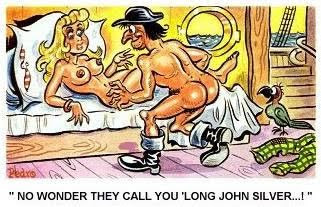
Hardangerfjord in Hordaland, Norway
Formation
Fjords are formed when a glacier cuts a U-shaped valley by abrasion of the surrounding bedrock. Many such valleys were formed during the recent ice age. Glacial melting is accompanied by rebound of Earth's crust as the ice load and eroded sediment is removed (also called isostasy or glacial rebound). In some cases this rebound is faster than sea level rise. Most fjords are deeper than the adjacent sea; Sognefjord, Norway, reaches as much as 1,300 m (4,265 ft) below sea level. Fjords generally have a sill or rise at their mouth caused by the previous glacier's terminal moraine, in many cases causing extreme currents and large saltwater rapids (see skookumchuck). Saltstraumen in Norway is often described as the worlds strongest tidal current. These characteristics distinguish fjords from rias (e.g. the Bay of Kotor), which are drowned valleys flooded by the rising sea.

A historic photograph of the Geirangerfjord in Norway
Fjord features and variations
Coral reefs
As late as 2000, some coral reefs were discovered along the bottoms of the Norwegian fjords. These reefs were found in fjords from the north of Norway to the south. The marine life on the reefs is believed to be one of the most important reasons why the Norwegian coastline is such a generous fishing ground. Since this discovery is fairly new, little research has been done. The reefs are host to thousands of lifeforms such as plankton, coral, anemones, fish, several species of shark, and many more. Most are specially adapted to life under the greater pressure of the water column above it, and the total darkness of the deep sea.
New Zealand's fjords are also host to deep sea corals, but a surface layer of dark fresh water allows these corals to grow in much shallower water than usual. An underwater observatory in Milford Sound allows tourists to view them without diving.
Skerries
In some places near the seaward margins of areas with fjords, the ice-scoured channels are so numerous and varied in direction that the rocky coast is divided into thousands of island blocks, some large and mountainous while others are merely rocky points or rock reefs, menacing navigation. These are called skerries. The term skerry is derived from the Old Norse sker, which means a rock in the sea.
Skerries are most commonly formed at the outlet of fjords where submerged glacially formed valleys perpendicular to the coast join with other cross valleys in a complex array. The island fringe of Norway is such a group of skerries (called a skjærgård); many of the cross fjords are so arranged that they parallel the coast and provide a protected channel behind an almost unbroken succession of mountainous islands and skerries. By this channel one can travel through a protected passage almost the entire 1,601 km (995 mi) route from Stavanger to North Cape, Norway. The Blindliea is a skerry-protected waterway that starts near Kristiansand in southern Norway, and continues past Lillesand. The Swedish coast along Bohuslan is likewise skerry guarded. The Inside Passage provides a similar route from Seattle, Washington and Vancouver, British Columbia to Skagway, Alaska. Yet another such skerry protected passage extends from the Straits of Magellan north for 800 km (500 mi).
Freshwater fjords
Some Norwegian freshwater lakes which have formed in long glacially carved valleys with terminal moraines blocking the outlet follow the Norwegian naming convention; they are named fjords. Outside of Norway, the three western arms of New Zealand's Lake Te Aneu are named North Fiord, Middle Fiord and South Fiord. Another freshwater "fjord" in a larger lake is Baie Fine, located on the northeastern coast of Georgian Bay of Lake Huron in Ontario. Western Brook Pond, in Newfoundland's Gros Morne sea, so is not a fjord in the English sense of the term. Such lakes are sometimes called "fjord lakes". Okanagan Lake was the first North American lake to be so described, in 1962. The bedrock there has been eroded up to 650 m (2,133 ft) below sea level, which is 2,000 m (6,562 ft) below the surrounding regional topography. Fjord lakes are common on the inland lea of the Coast Mountains and Cascade Range; notable ones include Lake Chelan, Seton Lake, Chilko Lake, and Atlin Lake. ootenay Lake, Slocan Lake and others in the basin of the Columbia River are also fjord-like in nature, and created by glaciation in the same way. Along the British Columbia Coast a notable fjord-lake is Owikeno Lake, which is a freshwater extension of Rivers Inlet. Another area notable for fjord lakes is northern Italy and southern Switzerland - Lake Como and its neighbours.



























 SSh ... IT Department
SSh ... IT Department




